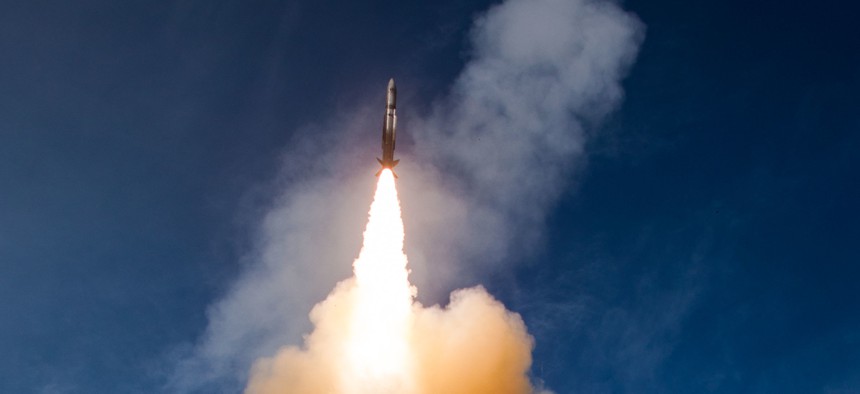Spooked by North Korea, Lawmakers Resurrect an Old Missile-Defense Idea
Technical experts say space-based interceptors haven’t gotten any more practical since the Reagan era, but House lawmakers still want the Pentagon to plan for them.
There’s not much Washington can do about North Korea’s quest for a nuclear-tipped ballistic missile that can hit a U.S. city, and so lawmakers might be forgiven for dusting off an idea that’s been around since the Reagan era: a space-based interceptor system.
That may be a cool mental image — “this idea that we'd have these orbiting sentinels that would protect the country,” but the “mundane reality” is far different, said Jeffrey Lewis, the founder of Arms Control Wonk and a professor at the Middlebury Institute of International Studies.
The idea, in brief: The U.S. would launch and maintain low-Earth-orbit satellites armed with interceptors to shoot down enemy ballistic missiles during their boost phase, when they’re slowest and most vulnerable.
This defensive network would “augment and supplement” terrestrial systems by “reducing the number of targets requiring midcourse interception,” according to a recent report from the Center for Strategic and International Studies.
There are several reasons the idea works better in theory than in practice — more on those later — and the Pentagon hasn’t seriously looked into the possibility since the 1990s. But with Pyongyang’s hostile behavior on lawmakers’ minds, some of them say it’s time to revisit the idea.
In this year’s defense bill, the House Armed Services Committee added $30 million to the Missile Defense Agency’s 2018 budget request to start developing a space-based interceptor layer to guard against a given region.
“The threat from the world’s most dangerous weapons has indeed never been greater, and now is the time to finally build a space-based missile defense layer to cover the gaps and seams in our missile defense architecture,” Rep. Trent Franks, R-Ariz., said during the defense bill’s markup last week.
Franks’ amendment adding that money also requires the MDA to deliver a plan for space-based interceptors to the committee within a year, and to establish a “space test bed” to look into options.
The idea has resurfaced again and again, almost like a zombie, said Theresa Hitchens, a researcher at the Center for International & Security Studies at Maryland. The 2016 National Defense Authorization Act directed the MDA to assess space-based defenses as an alternative to the U.S.’s current ground-based missile defense system.
“It keeps resurrecting itself — it gets killed and gets back up again,” Hitchens said. “There are a lot of people in Congress and in the Republican Party that have had this goal for space-based defense interceptors since the Reagan era, and in some ways…it’s kind of like finding the holy grail.”
These days, there’s another driving factor, she said: “People are freaked out about North Korea.”
Franks confirmed that’s why he offered his amendment.
“It’s time to assume, according to [outgoing MDA Director Vice] Adm. [James] Syring, that North Korea can reach the United States with a nuclear warhead,” Franks said last week. “With some of the things that are coming in our direction…we’re going to have to get left-of-launch and get into boost phase, and space is our opportunity to do that.”
We took the single biggest step since Reagan in preventing a nuclear attack by passing the space-based missile defense layer amendment #NDAA
— Rep. Trent Franks (@RepTrentFranks) June 29, 2017
His amendment calls for a regionally focused space-based layer to complement the terrestrial system. But experts say physics simply doesn’t allow this. If you want to park a satellite over North Korea, you can put it in geosynchronous orbit, some 22,000 miles up. But that’s too far away to react to a missile launch; your interceptors must be much closer to the ground. But satellites in low-Earth orbit race around the globe; any given interceptor would be within range of North Korea for just a few minutes at a time.
“Basically, to build a space-based interceptor system, you have to provide approximately global defense for the entire world,” Lewis said. ”And it's a really thin layer, unless you put many, many, many satellites.…It's just the math of putting so many satellites in orbit to get such a thin layer of defense almost never works.”
The financial math of space operations has changed since the idea was proposed 30 years ago, thanks to the advent of commercial launches and lower-cost satellites. But not enough to remove launch costs as a real limitation on any program, according to CSIS’s report. Especially since an operationally sufficient layer of satellites would still need to be reinforced by more interceptors to guard against mechanical failure or enemy attack.
“Somebody on the ground can shoot down one or two of those things, and there's a hole in your ability to catch that outgoing ballistic missile,” Hitchens said. “I don't think you can overcome this problem of the absentee ratio and the fact that it's a lot cheaper to shoot something up at a satellite, including one that's carrying a space-based missile defense interceptor, than it is to actually put those things up there.”
Franks’ office said his proposed regionally focused system would cost $20 billion to $30 billion over three decades. CSIS estimated a space-based intercept layer would cost between $67 billion to $109 billion.
There are also geopolitical concerns about such a system. Though lawmakers may envision it as a mitigation strategy for North Korea and other erratic regimes, it would affect the calculations China and Russia make about their own nuclear deterrents.
Still, it’s a necessary step to safeguard not only the U.S. homeland from North Korea, but also U.S. assets in space and current defenses, Franks and other supporters say.
First, however, the proposal would have to make it into the bicameral version of the defense bill. The Senate’s version of the NDAA includes no money for the MDA to develop space-based interceptors or create a testbed for relevant technologies.





